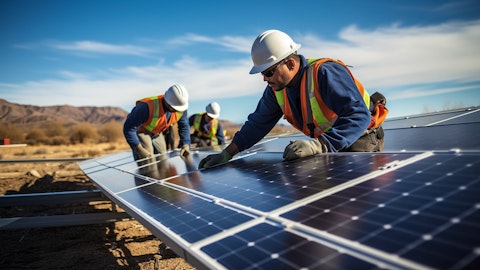And we have a Permian Basin growth rate for load that ERCOT has put out some studies that suggest that you could see 13 gigawatts of growth out west from 2023 to 2030. That’s oil and gas driven, it’s population driven. It’s also got some data center loan growth there. So, this is a general theme and then how that — I think will benefit an asset position like Vistra. And then specifically, how we might target our own assets, I view that as incremental upside, none of which is factored in to our long-range plan at this point. And in terms of when we’ll update from a capital allocation and how we think about longer-term buybacks, I’m going to have Kris jump in.
Kris Moldovan: Yes, Julian, I would say, you hit it with the Energy Harbor transaction. So as that closes, as we look forward, we talked about expecting to spend $2.25 billion on share repurchases over 2024 and 2025. We also have a little bit of debt to repay, and we have some growth that you see for our renewables and energy storage business. But on top of that, we do expect to have additional cash available for allocation that’s unallocated. We think it’s preliminary right now to get into the levels that, that is because we just want to make sure to get this Energy Harbor deal closed and put the two businesses, start integrating the businesses. But I do think, we will come back to you and talk about an additional amount that over the next two years that we have to allocate on top of the share repurchase estimate that we’re making. And so, I don’t believe that any of those opportunities would disrupt our pacing on share repurchases.
Julien Dumoulin-Smith: Right, even as a percent of total cash flow beyond ’25?
Kris Moldovan: We’ll — we’re going to continue to come back. I still think that the — we haven’t ever announced it as a percentage, but I think as a gross amount in this $1 billion-plus range on a per year basis, we don’t see anything that would move us off that now. But we will continue to evaluate that with our Board.
Julien Dumoulin-Smith: Wonderful. I know it’s in flight. Good luck, guys. We’ll speak to you then.
Kris Moldovan: Thank you, Julien.
Operator: Our next question comes from Durgesh Chopra from Evercore ICI — ISI, pardon me. Durgesh, you may proceed.
Durgesh Chopra: Yes. Thanks so much. Appreciate the time team. Good morning to you.
Jim Burke: Good morning, Durgesh.
Durgesh Chopra: Hey, good morning, Jim. Hey, Kris, just maybe this is a stupid question will ask it anyways. The TRA transaction that you did, does that have any implication on like your forward looking free cash flow guidance, you kind of talked to it as being somewhat cash flow accretive. So are there any implications as we think about sort of 2025 guidance and beyond?
Kris Moldovan : As we do. We do see some benefits on a — just a straight free cash flow basis, it is positive from free cash flow. So if you look — as we talked about, we spent about $150 million of cash and then we issued the preferred. And so over the course of five years, our cash cost for that repurchase is in the neighborhood of $350 million, our estimates that we previously had would have shown that the TRA payments would have been roughly twice that. So there is some free cash flow pickup and that will factor into our conversion percentage. We still see — obviously, we’re in a higher cost and higher interest rate environment. So there are puts and takes. And so I think we still feel really good about saying that our — our expectation is that we would be 55% on average over the planning horizon.
Some years, we expect to be more like this year, you see in our materials that we end up just over 60% conversion. In some years, depending on the timing of maintenance capital could be a little bit lower. But I think on average, 55%, the mid-50s is the right place for our conversion ratio.
Durgesh Chopra: Okay. That’s super helpful. But it is accretive to your cash flow guidance, but there are obviously other drags and you’re comfortable with the 55% range is the key takeaway there. Okay. Thank you. And then maybe just can I ask — I don’t want to jump the gun, but what to expect in terms of disclosures on the first quarter call, whether EBITDA is still the metric? And then in terms of forward-looking years, what to expect, if you could share any color?
Kris Moldovan : Yes. So we’re going to focus here on Energy Harbor and getting it closed. I do think that whether it’s on that call or a future call, we are going to continue to assess what is the best way for us to communicate the ongoing value of this company. And so I do think we will — at the very — we do expect to plan — we do expect to give updated guidance for this year. But as we go forward, what metrics we use and how we communicate what we see as the value of the business, we’re going to continue to work through that, and we will come back to you whether that. It could come on the May call, but it could come also later this year. We’re going to think through that and make sure that we’ve thought through all the issues.
Jim Burke: Durgesh, what I would add is, once we close Energy Harbor, we will go through a process to confirm the synergy numbers. So we’ll talk about that on the May call. That will then lead to the 2024 expectation, as Kris said, of the combined companies. We will also, as he noted in his script, we’ll talk about where we see the 2025 headed as well. And obviously, the synergies are part of that. Capital allocation, there will be an amount that’s still unallocated that we see that we will be talking to our Board with, with respect to how we think about the best use of that capital. But what you could expect to hear about in May, at least to 2024 with a nod to 2025 with our guidance and then these updated synergy expectations.
As far as the best metrics, clearly, with Constellation’s call yesterday, very successful in their description of how to think about the value drivers. For our business, where we have looked at it and since the buyback program was enhanced in 2021. So far, we’ve really focused on the return of cash and capital to the shareholders. And on a per share basis, between the buyback programs and the dividends, you’re seeing that in the sort of $4.45 on the high end and that’s an opportunity that’s per share. And so that’s just from a return of capital standpoint. In terms of the adjusted free cash flow before growth on a per share basis, it’s much higher on a stand-alone basis, that’s closer to $6 a share. As far as working through GAAP and working through the mark-to-market, working through depreciation and amortization, we will be taking a look at that.
What we’ve tried to focus on to date has been much more about the proof points around the capital we’re returning and the sustainability of that and frankly, the upsizing of that. But clearly, the investor response yesterday was super positive. And if there’s opportunities for us to be more clear about the value drivers and the comfort that investors are looking for, for the long term, we owe it to them. We’ll be certainly taking a look at that.
Durgesh Chopra: I appreciate that very much. Thank you both.
Operator: We are now taking a question from Michael Sullivan from Wolfe Research. Michael, please go ahead.
Michael Sullivan: Hey, everyone. Good morning.
Jim Burke: Good morning.
Michael Sullivan: Jim, you kind of answered this, but just wanted to confirm. So it sounds like the synergies from the original target, you’re going to kind of revisit and refresh. But the Energy Harbor guidance itself, what you’re putting out there today, is that just kind of what you saw originally? Or is that actually refreshed and just consistent as of today?
Jim Burke: Yeah, Michael, I would say it has been — we have been updating it ourselves as we’re tracking kind of through the process of working to close. We feel good about it. So when we looked at $700 million on a 12-month basis, I do think we’ll be in the ballpark of prorating 10th, 12ths of that number. If you do that and you add it to our Vistra stand-alone as we sit today, then you’re in the $4.5 billion sort of range for calendar year 2024. That’s above where we were when we announced the acquisition in March of 2023. The synergy numbers, I think there’ll be some upside to the synergy numbers, but not likely in calendar year 2024 because we thought we could close this deal later last year. So we’re getting a later start.
But I think by the end of this year, we’ll be about where we expected from a run rate perspective. I think there’s upside to the out years on how we’re thinking about it. So we’d expect to talk about that on the May call. But the way you’re thinking about it is correct, Michael. I think it’s always helpful to close a deal work with the teams day-in and day-out, make sure we understand all the assumptions and then affirm and potentially, we see a chance to upsize some things on the May call, we’ll do it at that time.
Michael Sullivan: Okay. Super clear. Thanks. And then we continue to get questions on this. Just can you give us the latest on where you are in terms of having nuclear fuel secured both for Comanche and to the extent Energy Harbor’s position?
Jim Burke: Sure. Yes, we believe we’re in really good shape. Michael, we have, as I’ve indicated on previous calls, we have, as Vistra done some additional procurement through time since we announced the transaction. Obviously, we had a high percentage likelihood in our view of being able to close the transaction. Either way, the markets continue to go up in price, and that’s been speculation on the part of a number of folks based on whether Russia pans or limitations would ultimately be put in place. So we have a physical procurement strategy that we are secure for both Energy Harbor sites and our site Comanche Peak through 2027 refuelings. And we feel good about that. We’re also substantially hedged into 2028 as well. So we feel good about the risk management around that.
And of course, long term, depending on where this goes with the domestic fuel supply capabilities and whether the federal government will incentivize more domestic capabilities for enrichment remains to be seen. But I think we have a very good line of sight and very consistent with everything that we’ve shared publicly so far and our expectations of this deal.
Michael Sullivan: Thanks for all the detail. I appreciate it.
Jim Burke: Thank you, Michael.
Operator: [Operator Instructions] And now we follow with a question from Angie Storozynski from Seaport. Angie, please go ahead.
Angie Storozynski: Thank you. Good morning. So maybe first…
Jim Burke: Good morning, Angie.
Angie Storozynski: Good morning. Maybe first with — yeah, the fundamentals of our markets are tightening, but we don’t see it in forward power curves and probably very low natural gas prices do not help. But I’m just wondering, if you think that there will be a step change in those power curves on the back of any big announcements about and data centers, you name it. We’ve seen some positive surprise in capacity prices in New England. I’m wondering if you’d hope to see a similar message being sent from the next PJM capacity auction, and again, how do you think we will see more of a forward-looking signal that the profitability of your assets is improving?
Jim Burke: Yes, Angie, thank you for that. New England was a better clear than we’ve seen in a while. In fact, about 50% higher in the 2027, 2028 auction than what we saw just prior in the previous auction. Good for our gas fleet, obviously, up in New England. PJM has delayed some of their auctions. So we have to play catch-up with PJM. So we’ll see what comes forward. There’s going to be a number of auctions that happen in the next 12 months to get caught up in PJM. There have been market reforms proposed for PJM. Some of those are going to be implemented. Some of them were not supported by FERC. So again, it’s still a little bit of a struggle as to what is going to be the effect on the capacity, things like market seller offer cap have been very difficult to move the needle on, which has had a dampening effect on capacity prices.
But this effective load-carrying capability or ELCC, where potentially the dispatchable assets get proportionally more credit than the intermittent. That’s an opportunity for the PJM capacity clear. So I think they are coming to the same conclusion that other grid operators, which is we — PJM used to be really flushed with excess capacity, but a lot of it is retiring. And the gas plants are critical because the intermittent sources for wind and solar are not nearly as naturally supported in PJM as they are in places like ERCOT in California. As far as Texas is concerned, as I mentioned, the spark, and you see it in the graph that Chris covered, the spark spread has definitely moved up. So gas prices went up and the Russia-Ukraine conflict have come back down.
Sparks have stayed elevated relative to that time frame, but they’re still strongly backwardated. And I think that still comes from the concern of how much renewables will continue to come in. And then also, will the market reforms support price formation in ERCOT. And ECRS was an example where price formation occurred last summer. There was a lot of concern from a lot of customers and others that maybe there was too much price formation. And so they start having to revisit the rules. And now I would say it’s just uncertain how some of these things like ECRS will play out. So certainty around some of these ancillaries will help certainty around PCM will help. That, coupled with the demand growth that is actualized on the ground I think, could help address some of the backwardation in ERCOT, which could then help address the investment signal.
But we’ve said that for a while, ERCOT has been backwardated for about forever. If you go long enough out back in history, so the prop will always be pretty strong because that’s where a reality meets the supply/demand. But out in the forwards, you still see concern around whether the price signals will be there. And that’s part of the Texas market reform and ultimately, the gas plant investment that folks are considering. But I think that’s still yet to play out.
Angie Storozynski: Okay. And then changing topics. So I understand that the Energy Harbor transaction hasn’t closed, but I’m sure that was taking months to close. You were probably looking at the assets you’re acquiring and potential revenue and cost synergies. So we’re waiting for probably the first colocation of a data center within nuclear plant. And I’m just wondering, one, if you think that this will have an impact on other nuclear power owners? And also, how do you see the portfolio and large portfolio of nuclear plants vis-à-vis that opportunity. I’m mostly asking most of your sites are single unit nuclear plants. So there’s this no backup from additional units that a data center would get? And would you think that it’s somewhat of an impediment to the pursuit of such a colocation strategy on your sites?
Jim Burke: Yes. Angie, it’s a fair question. I would say the data center growth behind the meter at a nuclear plant is still early stages for anybody in the market. It’s certainly been discussed and being considered, but it still takes time for some of these to play out. I do think the two units having an opportunity to have redundancy will be attractive for customers. So Veeva Valley has been the one that is it working towards this path and then Comanche Peak as well. However, I’ll go back to a comment I made on an earlier question, between the colocation companies and the hyperscalers, speed is very important to them. So while the redundancy may not be there on a single unit site, pulling from the grid would still be an option.
And that’s how we manage the behind the meter that we work with, with our gas plant. So while there is a preference list from a customer standpoint of things that check every box, I think there’s going to be a balance of factors that the potential data center companies will be considering when they do a site selection. And speed is one of them. Economics is one of them, access to water is another one. So there’s a number of variables there beyond just the two units versus one unit. But all things being equal, that would probably be a preferred site Angie. But I — the fact that we’re being approached about gas plants tells you that it isn’t just about the carbon attributes. It’s about some of these others as well.
Angie Storozynski: Okay. And then lastly, I’m sorry that I’m asking so many questions. But if you were to be approached by some of these tech companies and offer long-term contracts. And again, against a very depressed forward power curve, would you be willing to actually lock in some of these assets? Or are you basically thinking that we’re about to see a step change in how the market assesses the value of your assets? And so there’s no need to actually lock the — the value at the bottom of the — a potential bottom of the sell-the-cycle?
Jim Burke: Yeah. That is an excellent question, Angie. I don’t know if it’s an all or nothing approach because we have a lot of assets with a lot of length. But with — if you’re speaking nuclear first with a production tax credit that escalates with inflation and our curves are basically sitting at those levels, you would need to see something attractive from a customer to lock it in and it would have to be at a reasonable premium to what your view is of the alternative, which is to stay long to have the PTC as some support on the bottom, but still retain some of the upside for that asset. For other assets like the gas plants, I think you could potentially have more flexibility because you’re not necessarily going to see that — you’re not going to see the PTC support for some of those.
But from a nuclear standpoint, I don’t think there’s a rush here for the reasons that you mentioned. And it also takes time because of the complexity of these to put these in place. So I think we agree with how you’re framing the question, Angie, and we’re going to be patient about how we think about these opportunities.
Angie Storozynski: Thank you.
Jim Burke: Thank you, Angie.
Operator: And with that, we conclude the question-and-answer session. I would like to turn the conference back over to Jim Burke, the CEO of Vistra for some closing remarks.
Jim Burke: Perfect. Thank you. First, I want to start with just thanking the Vistra team. 2023 was a heck of a year, and we look forward to what is in store with Energy Harbor, who I also want to thank they have done an excellent job running a business during a year of uncertainty, whenever an announcement is made, the units are running very well. The team has been incredibly cooperative on our integration efforts. And we’re excited about this Friday and becoming one team. We’re going to continue to execute our plan, which includes returning capital in an environment of very strong long-term fundamentals. I think that came out in a number of the questions that we were asked. And I also hope that we get to see many of you in New York next week. We’ll be up there for a couple of days, and it’s always good to see folks face-to-face. So, thank you for your time this morning, and we’ll hopefully see you soon.
Operator: And the conference has now concluded. Thank you for attending today’s presentation. You may now disconnect. Have a good day.



